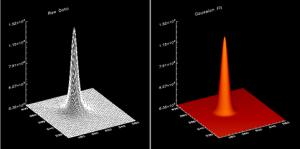Keck Adds $4 Million Laser System
A $4 million laser system was successfully deployed from the W. M. Keck Observatory and was projected on the sky for the first time on Dec. 1.
The laser system increases the resolution and clarity on the telescopes, according to Keck officials.

The top spot is the artificially created laser guide star in the mesosphere with sodium atoms excited by the laser. The star pattern and surrounding lopes, seen by the acquisition camera, show the structures of the telescope and the equipment in the light path. The bottom spot is a reflection of the laser star on the camera optics. W. M. Keck Observatory photo.
Keck’s first Laser Guide Star Adaptive Optics system on a large telescope was commissioned in 2004 on the Keck II telescope. That laser helped to reveal the black hole at the center of the Milky Way, a major astronomical discovery.
In 2011, a second laser system was installed on the Keck I telescope, making it the leader as the premiere Adaptive Optics research facility in the world.
Using Keck Observatory’s Laser Guide Star systems, astronomers are able to create an artificial star in the earth’s mesosphere at an altitude of about 60 miles. With this artificial guide, star astronomers are able to measure the aberrations introduced by turbulence in the earth’s atmosphere.
A six-inch diameter deformable mirror with 349 actuators is then used to correct these aberrations at a rate of 1,000 times per second, providing near-perfect detail for planets, stars, and galaxies.
“The Next Generation Laser System is the third generation of lasers at Keck Observatory, which has been pioneering Laser Guide Star Adaptive Optics on big telescopes since 2001,” said Jason Chin, the project manager for the new laser at Keck Observatory.

A point spread image shows the symmetry of the artificially created guide star in the mesosphere. W. M. Keck Observatory photo.
Keck’s newest laser is the result of a collaboration with the European Southern Observatory that aimed to develop a more efficient and powerful facility class commercial laser for astronomy.
The laser, fabricated by TOPTICA in Germany and MPBC in Canada, meets the goals of efficiency and power.
In addition, the new system dropped considerably in power usage from 80 kW to 1.2 kW while increasing performance by ten. The laser can also turn on in a matter of five minutes, compared to the previous laser’s five to six hours.
The previous laser was decommissioned in October to make room for the new laser.
Funding for the laser came from the Gordon and Betty Moore Foundation, the W.M. Keck Foundation, and Friends of Keck Observatory, with initial seed funding provided by the National Science Foundation.
Over one-third of the $4 million budget was spent in Hawai’i designing and installing the systems and related infrastructure to support and operate the new laser. The rest of the money, $2.5 million, was spent on the laser itself.
Infrastructure was made to support two additional lasers. Once funded, those lasers will be added to the system.













